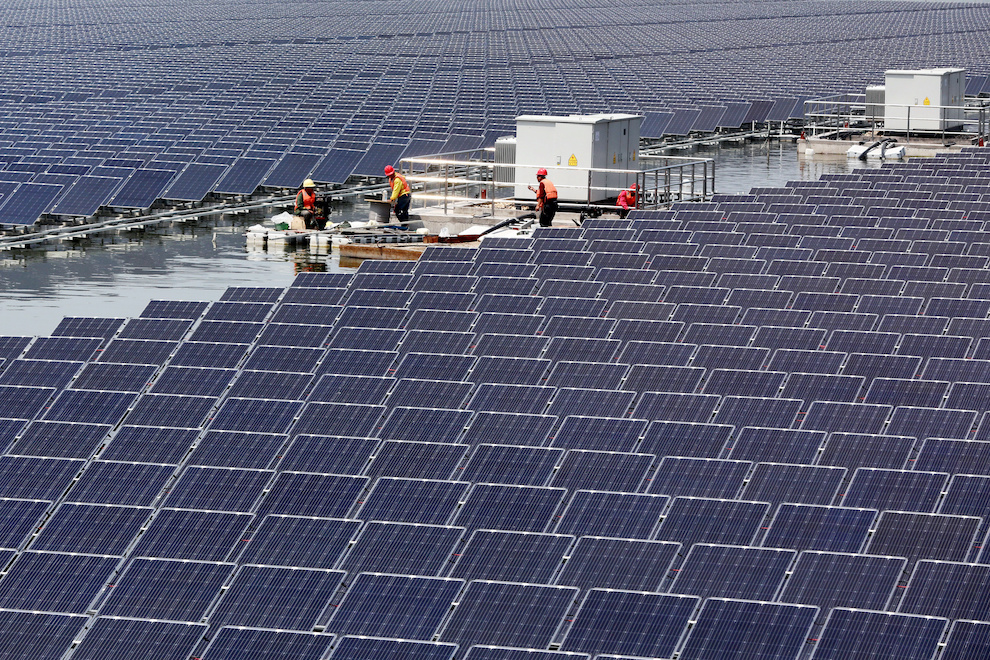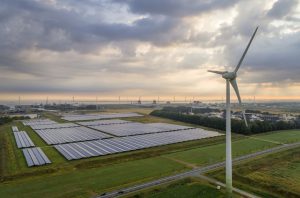China could add a further 200 gigawatts (GW) of solar power in 2024, according to a note on Friday by Carbon Brief, which cited remarks by Wang Bohua, honorary chairman of the China Photovoltaic Industry Association (CPIA).
The country installed more than 216 GW of solar power in 2023, according to data released in late January by the National Energy Association, which said its solar generation capacity more than doubled last year.
The country built in excess of 216 gigawatts (GW) of solar power in 2023, while its wind power generation capacity jumped by 20.7%, the data showed.
ALSO SEE: EU Says China EVs Funded by Subsidies, Plans Retroactive Tariffs
Overall power generation capacity grew by nearly 14% over the course of 2023 to reach a total of 2,919 GW.
To put the latest comments in perspective, 200 GW is equivalent to the total solar capacity installed in Europe at the end of 2022, it said.
Push for batteries, pumped storage, coal retrofits
Meanwhile, an official with China’s state planner, the National Development and Reform Commission (NDRC), said a key goal for this year will be “commissioning more than 80 gigawatts of pumped storage power stations”, so that it reaches “more than 20% of new energy power generation in the national energy mix” by 2027.
They also plan to retrofit all coal-power plants so they become more flexible (if possible).
Regions that have relatively high proportions of renewable energy, but insufficient peaking capacity, must ensure their coal-fired power plants can run at “below 30% of the[ir] rated load”, David Fishman, senior manager at the Lantau Group, said on Twitter.
Carbon Brief said that priorities in developing energy storage capacity included developing pumped storage, building “new energy storage” – predominantly batteries – on the power supply side and developing storage on the user side, according to China Energy Net.
They also want to optimise the scale and layout of new energy storage for power transmission and distribution, and develop new technologies.
In related news, the Work Report read out by Premier Li Qiang at the opening of the National People’s Congress – the annual parliamentary meeting – in Beijing this week said China would aim to cut its energy consumption per unit of GDP by 2.5% over the coming year, although that target has been described as ‘modest’ by some foreign analysts.
China still committed to fossil fuels
However, the NDRC report said the 2.5% target reflects the fact that energy consumption will increase this year. Instead, it said that the energy intensity target will now “exclud[e] non-fossil fuels and coal, petroleum and natural gas consumed as raw materials”.
This shift means the government has “redefined” the energy intensity target to mean “fossil fuel intensity”, Lauri Myllyvirta, senior research fellow at the Asia Society Policy Institute was quoted as telling Carbon Brief, making the 2025 target “very soft-ball”.
By his estimate, if China’s energy intensity – under the new method of calculation – does fall by 2.5%, it would translate to a 3% fall in carbon intensity “at best”, which is “very far from the 7% [fall] they need”, per his recent Carbon Brief analysis, to meet the 2025 target of an 18% reduction in carbon intensity.
Overall, that suggested China is still prioritizing “high quality and greater security” – and doubling down on fossil fuels.
Beijing’s insistence on continued use of coal and increased development of oil and gas, which is thought to stem from competing interests in its political system, has troubled environmentalists at home and abroad, who say such projects will soon be stranded assets.
So, while China continues to lead the way in the “new three” clean technologies – adoption of electric vehicles, solar power and batteries – there is still deep concern on over-capacity and when it will phase down its reliance on dirty power sources.
- Jim Pollard, with Reuters
ALSO SEE:
China Dominates Clean Energy, as Well as EV Batteries – FP
Australia Speeds up Its Transition to Green Power – SMH
Indonesia Will Launch $2-Billion EV Fund With China’s CATL
China’s Zijin to Invest $380m in Argentina Lithium Plant
Australian Minister Confident ‘Sun Cable’ to Asia Will Proceed
‘Local Protectionism’ Slowing China’s Clean Energy Transition
China Employs Almost Half of World’s Green Energy Workers
























